
ABSTRACT
Solar energy-based power plants are torch bearers in driving the green energy revolution and sustainable low carbon emissions. Solar power plants are also designed to deliver commercial value. High performance, cost-effectiveness and efficient maintenance are in high demand in solar power plants due to low margins in business models. This article explains an asset management model that transforms a typical operation and maintenance model into an asset management model integrating risk management, life cycle costing, optimisation plans and continuous improvement.
1.0 Overview of PV plant and stakeholders’ expectations
A typical layout of a solar power (photovoltaic power) park and the connection of the different components as a system are shown in Figure 1. A grid-connected solar plant system uses solar modules (PV panels) to generate direct current power. The panels are either connected in series or parallel to generate the necessary voltage. Power from the solar modules through array junction boxes (AJB) is then fed to an inverter, which converts the DC power to alternating current compatible for grid synchronisation. Power transformers are used to step up the voltage to grid level, and a circuit breaker is used for appropriate switching actions.
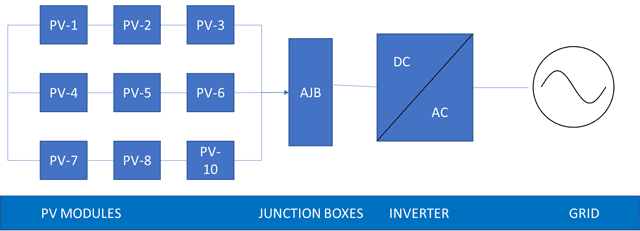
Asset management activities of solar power plants are always of high interest to stakeholders. Many asset management service providers are available in the market with an approach of providing asset management activities as a service, but with a generally low success rate due to limitations in the commercially available asset management systems/software codes used in practice. These systems are generally focused on developing or adapting a workflow and entering the results in a database. However, in contrast, stakeholders expect decision-making enabled systems/ software codes that are built on a robust framework methodology.
2.0 Current state review
Typical operations and maintenance (O&M) organisations mainly focus on the following operation and maintenance elements, with key performance indicators as applicable:
• Environment, health and safety
• Personnel and training
• Technical asset management
• Operations
• Maintenance
• Revamping
• Spares
• Data monitoring.
O&M best practice guidelines are available for these elements in detail through many reputable organisations such as Solar Power Europe [1]. A typical operation and maintenance model is focused on these elements, but achieving excellence is always challenging, due to a lack of guidance on frameworks. The current model typically used in PV plants, with missing asset management frameworks, is illustrated in Figure 2.
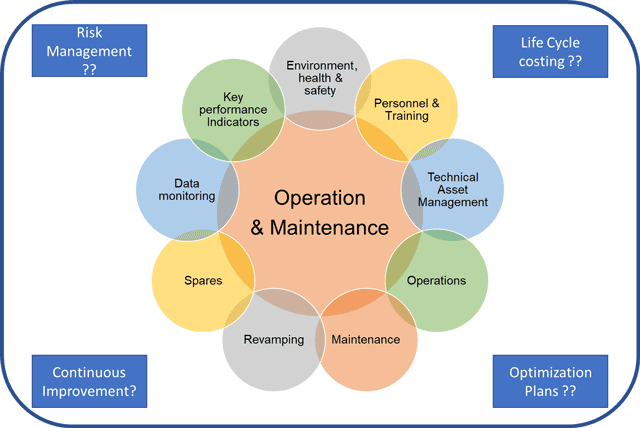
It is obvious from Figure 2 that important aspects of asset management such as risk management, life cycle costing, optimisation plans, continuous improvement and decision making frameworks are not integrated into the current OMM model. Therefore, it is likely that stakeholders’ expectations are not met.
3.0 Improved integrated OM and asset management model proposed
An effective asset management system should be capable of providing necessary decision making information to stakeholders. This article proposes integrating the frameworks by modifying the OM model in Figure 2. The proposed integrated OM and AM model is shown in Figure 3.
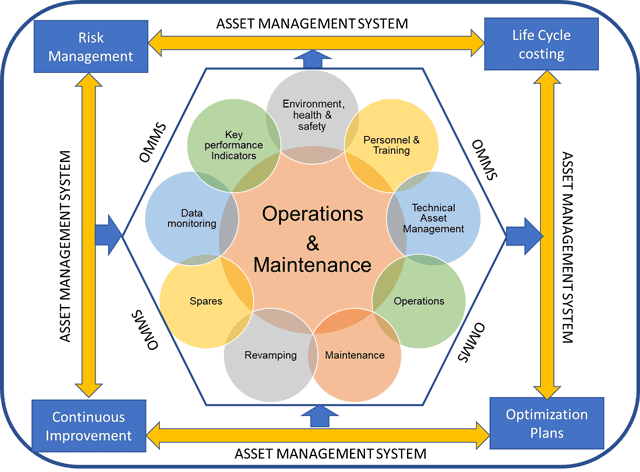
4.0 Frameworks for the asset management system
In this article, the four key framework steps as elements of the AM system in the proposed modified model are explained further.
4.1 Environmental Management
Solar power plants, as a solution for green energy, especially need to ensure that environment management aspects are well structured.
Repair, reuse and recycle, typically stated as the 3R process, is a known methodology in waste management systems. For solar panels, repair and reuse are technically challenging because there are age-related problems that prevent them being restored to their original design function. Technology related to solar panel recycling has yet to be established.
Abundant land is used for solar parks, which offers an excellent opportunity to enhance the natural environment. The natural ecosystem impact of such extensive land use can be minimised and many environmental co-benefits can be achieved by adopting proper ecosystem and nature management procedures.
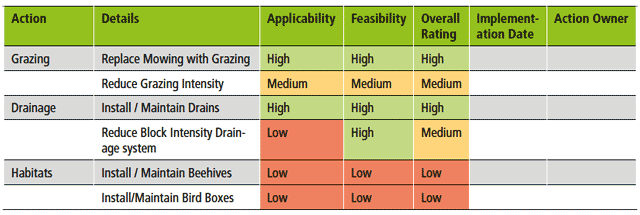
The ecosystem and nature management framework [2] a decision support tool for management to implement feasible actions and identify benefits. Each action can be analysed for applicability, feasibility, and overall rating for a clear decision-making process.
This is typically demonstrated in Table 1 for a site with a detailed action plan. Table 1 specifies a list of possible actions towards better environment management. A “high” grade for each element is desirable and better for the environment. A detailed assessment of applicability and feasibility is converged to produce an overall rating, and a set of actions to be agreed.
4.2 Competence management
Competence management is the ability to achieve the organisational objectives from the available personnel in an effective way. This framework is an extension of the position qualification review, a process by which an individual’s skills are periodically validated to make sure they remain competent for the tasks they are undertaking. In the extended framework, training inputs and assessment inputs are considered from the point of view of work authorisations and continuous improvement.
The competence management framework ensures that the authorisations in the position qualification review are formulated for the continuous improvement process, and that training inputs arising from the assessment procedures are considered for the training calendar (Table 2 – over page).
• Continuous improvement: Each authorisation assessment mentioned in the position qualification review process is defined for frequency of reassessment and reauthorisation.
• Training calendar: Inputs to the training calendar for employees are organised from this assessment process and this training will be focused to fill the learning gaps.
This framework will help each employee to develop the skills required for each activity at the plant.
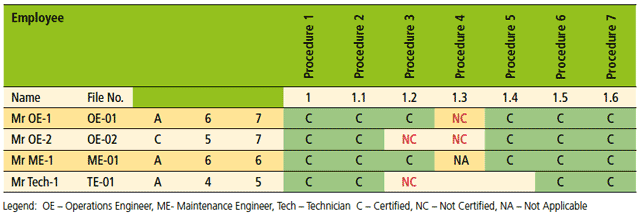
4.3 Maintenance management system
The maintenance management framework consists of different tools integrated into one system to design the strategy, implement the maintenance and measure the maintenance effectiveness and efficiency, with a continuous improvement loop to modify the maintenance strategy as we learn from experience. Different tools from the maintenance management framework are shown in Figure 4. The selection of the maintenance approach, understanding failure modes and associated risk are demonstrated through the DMG and FMECA analysis.
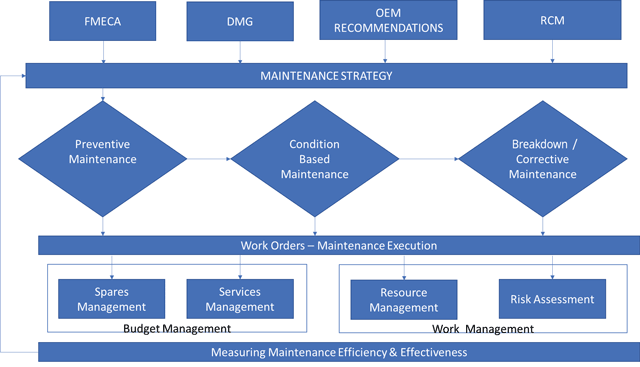
4.3.1 Decision-making grid
The decision-making grid (DMG) [3] is a tool used to decide the maintenance strategy among similar equipment. A plot of downtime versus failures is used to decide the type of maintenance required for the assets, from the following categories:
• Skill level upgrade (SLU)
• Design out maintenance (DOM)
• Fixed-time maintenance (FTM)
• Condition-based maintenance (CBM)
• Operate to fail (OTF).
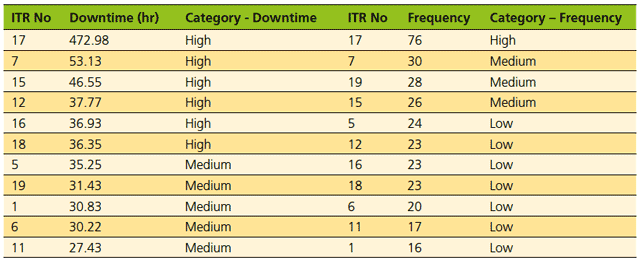
Implementation of the decision-making grid tool for inverter failure is discussed here. For 17 inverters in a plant, the downtime and frequency of failure of each are tabulated as per Table 3. These are also marked in the DMG plot as shown in Figure 5. Figure 5 enables a clear decision to be taken. Inverter ITR-17 needs a “design out maintenance” strategy due to its high failure rate, requiring major changes in the inverter to minimise the failures or replacement by a new inverter.
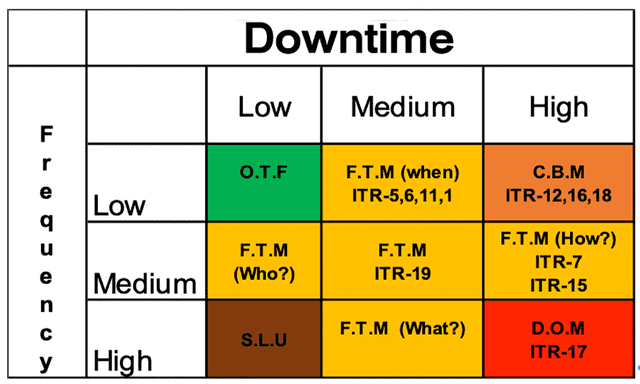
4.3.2 Failure mode effects and criticality analysis
Failure mode effects and criticality analysis (FMECA) is a method aimed at developing quantitative failure analysis linking the potential failure modes and impact of failure with causes of the failure. A typical FMECA example of one inverter is illustrated here, where the failure mode, cause, effect, and maintenance strategy are discussed with a risk priority number (RPN) score compiled from multiplication of occurrence, detection and severity [4].

Criteria for occurrence, detection and severity considerations are defined in Table 4. Risk priority number scores are listed for inverters in Table 5. Different failures in the inverter system are analysed to show the risk associated. A maintenance strategy is then required to reduce the RPN by improving detectability.
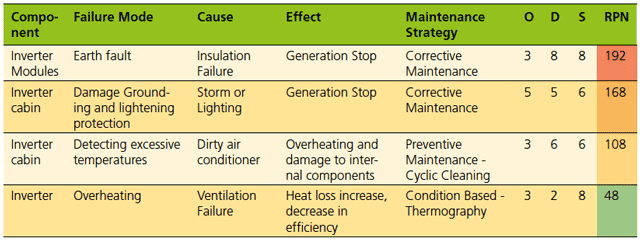
4.4 Spare parts management
Spare parts management presents the challenge of striking a balance between the impact of a breakdown and loss of revenue versus spares maintenance costs.
Mean time between failures (MTBF) and mean time to repair (MTTR) parameters from the computerised maintenance management system (CMMS) are used for all critical systems such as inverters, transformers and high voltage circuit breakers, to formulate a cogent approach. A spare parts management framework can be based on three major aspects: the preventive maintenance-based requirement, the contingencies-based requirement, or on corrective maintenance history.
Decision-making tools are of vital importance with respect to the contingency and corrective maintenance spare requirements. Considering the MTBF rate and installed quantities, a calculation of expected failures with respect to the current stock is discussed to give a clear understanding of the risk faced by not maintaining spares in adequate quantity (Table 6).

Table 6 demonstrates a justification to maintain adequate spares. The risk of current stock maintenance is shown in the column for out-of-stock risk. A high percentage in this category denotes a priority for increased stock levels to reduce production losses.
It is evident that the PV modules as currently maintained put the current stock level at risk. Additional stock is demanded because the MTBF rate and existing quantities are not balanced. The purchase of additional PV modules as spares is fully justified.
Regarding the inverter and transformer, current stock maintenance is well justified. The holding cost of spares and the downtime cost if a shortage of spares occurs are also included in Table 6, and should be considered for further decision-making analysis.
5.0 Case studies
Solar Power Europe [1] developed a best practice guideline for solar operation and maintenance activities. The model considers assessment criteria to measure the performance of O&M activities. To assess the performance of the proposed improved integrated OM and AM model, a case study of a 200 MW solar plant was assessed before and after implementation. A 30% overall increase in assessment score was observed. Detailed improvement in each element of assessment is demonstrated in Figure 6.
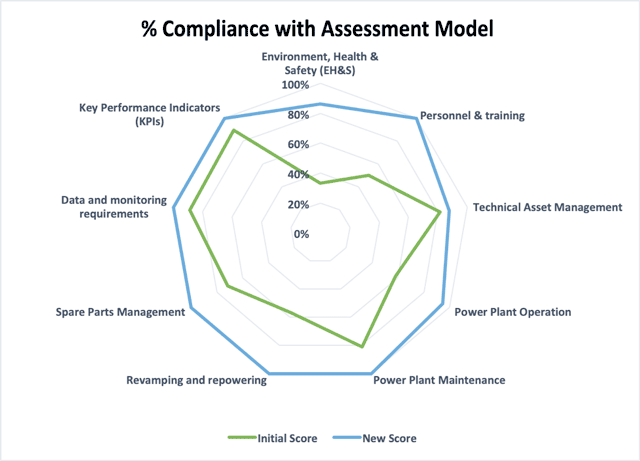
6.0 Conclusion
The proposed integration of the AM system, with risk management, optimisation, and continuous improvement aspects, into the existing OM model for solar power plants makes the model more robust. A similar approach should be used for other industries. Key benefits are as follows.
• Stakeholder management can be strengthened, and prudent operation of assets is emphasised
• Optimisation of asset performance and risk management is now structured
• Continuous improvement with experience is possible
• Best value from an asset can be recognised
• Maintenance effectiveness and optimisation is possible.
References
[1] Chiantore P V, Ware B.
Operation and Maintenance best practice guidelines
version /4.0: Solar power Europe. 2019.
[2] Solar Park Impacts on Ecosystem Services (SPIES) ,
SPIES tool cites and used on January 2020 ,
Available from https://www.lancaster.ac.uk/spies/
[3] Labib AW.
World‐class maintenance using a computerised maintenance management system. Journal of Quality in Maintenance Engineering. 1998 Mar 1.
[4] Sarr ON, Barro FI, Niasse OA, Dia F, Mbengue N,
Ba B, Sene C.
Analysis of Failure Modes Effect and Criticality Analysis (FMECA): A stand-alone photovoltaic system. Sci. J. Energy Eng. 2017 Mar 27;5:40-7.

Karthik Sriramakavacham
MSc Reliability Engineering and Asset Management (REAM)
The University of Manchester, UK
Karthik.Sriramakavacham@Manchesterac.uk

Prof Jyoti Sinha BSc, MTech, PhD, CEng, FIMechE
Programme Director,
MSc Reliability Engineering and Asset Management (REAM)
The University of Manchester, UK
Jyoti.Sinha@Manchester.ac.uk

